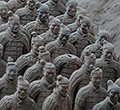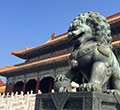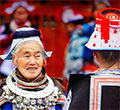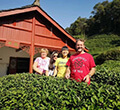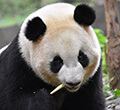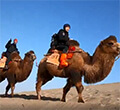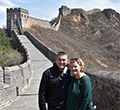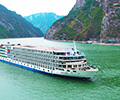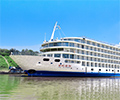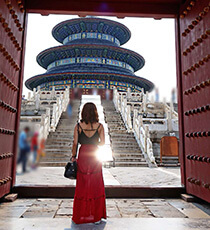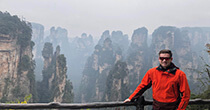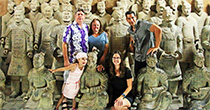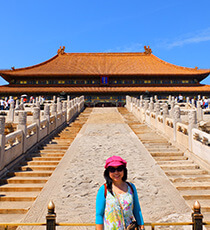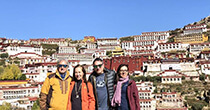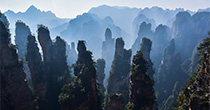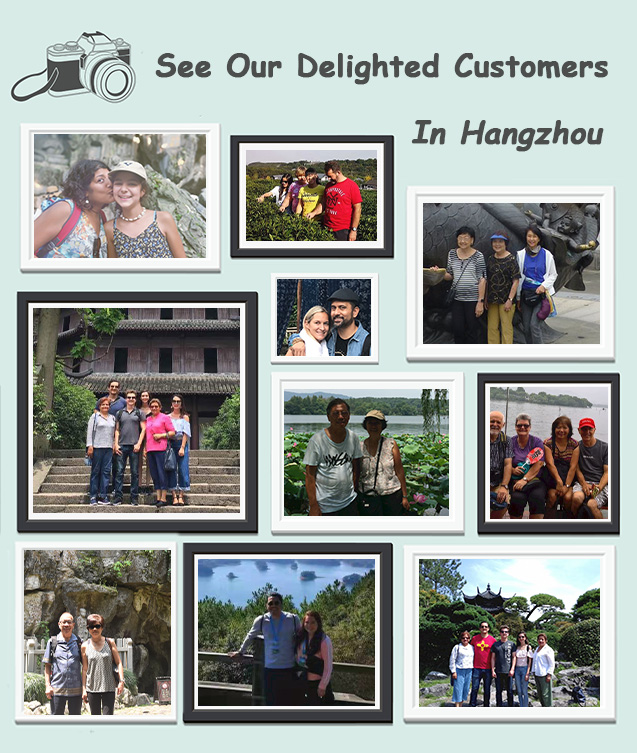Brief Introduction to Lingyin Temple
Lingyin Temple is the wealthiest and most recognized Buddhist temple in Hangzhou with a long history of 1,700 years. Nested between and back Beigao Peak and fronted Feilai Mountain, it has been long regarded as a wonderful Buddhist and poetic destination - cloud-wrapped mountains, massive trees, the ancient temple, religious grottos, delicate rock carvings...It has been honored as one of the most important temples in Jiangan Region for its Buddhist importance in Song Dynasty. With so many to cherish, it was also ranked as a national Key Cultural Relics Protection Unite and AAAAA scenic spot.
- ☛ 2 Days Essence of Hangzhou Tour
- ☛ 3 Days Classic Hangzhou Tour (at Leisure Pace)
Best Lingyin Temple Tour:
History of Lingyin Temple
Lingyin Temple was a Zen Buddhist temple the originally built in 326 AD by an Indian monk called Huili (慧理和尚). As Huili came to Hangzhou, he found the peaks extraordinary and unworldly and there must be some soul of immortals retreated here. He named it Lingyin which literally translated as soul’s retreat. In the Northern and Southern Dynasties (420-589), it was expanded with the bestowing land from Liangwu Emperor (梁武帝). Lingyin Temple has developed and prospered during the Five Dynasties (907-960) and the population of monks soared to about 3,000. Emperor Kangxi visited to Lingyin Temple as he travelled incognito to Jiangnan in 1689. Seeing the dense forest and puffy clouds, Kangxi named Lingyin Temple as “Yunlin Chan Temple” (云林禅寺). However, people got accustomed to calling it Lingyin Temple, so its original name keeps till today. With such a long history, Lingyin Temple has experienced damage and renovation several times.
Lingyin Temple Highlights
Lingyin Temple has a lot, both nature and culture, for you to explore. In spite of crowded tourists in weekends or holidays, the ambience of the entire temple is so peaceful making you relaxed. The main halls of Lingyin Temple were built in the axis, including Hall of Heavenly Kings, Grand Hall of Great Sage, Palace of Medicine Buddha, Dharma Hall & Sutra Library and Huayuan Palace. Several other halls sit in the two side of the axis
Hall of Heavenly Kings
The first building you meet after you enter Lingyin Temple is the astonishing Hall of Heavenly Kings (天王殿). A horizontal inscribed board with “Yun Lin Chan Si”, which is written by Emperor Kangxi, hangs highly above the gate. As you step in, an ornate cabinet housing Maitreya (the Future Buddha) will catch your eyes. The Buddha with a big belly seems laughing a hearty laugh, which means that he always tolerate the intolerable and laugh at the ridiculous. At the back, facing up the hill, is the statue Skanda Buddha on golden helmet and gold leaves, sculpted from precious camphor wood. The statues of the Four Heavenly Kings are standing in the two sides of the great hall, looking fierce and imposing.
Grand Hall of Great Sage
Called Juehang Palace originally, the Grand Hall of Great Sage (大雄宝殿) is a two-storied building with a three-eave roof which jumps to a pinnacle of 33.6 meters. In the center sits a startling statue of Shakyamuni on a lotus flower. With a height of 24.8 meters, it is one of the biggest camphor-wooden sitting statues and one treasured religious artwork. Behind the giant statue is a group of stereoscopic statues: Bodhisattva carrying holy bottle, surrounded by 150 small figures. You can also enjoy many lively scenes described in Buddhist sutras.
In front of Grand Hall of Great Sage situate two 9-story octahedral stony pagodas with fine carvings on each side. As great architect Liang Sicheng identified, the two pagodas were built in late Five Dynasties.
Palace of Medicine Buddha
Palace of Medicine Buddha (药师殿) is a 20-meter long and 12-meter wide hall where Three Saints in East are enshrined, including Medicine Buddha, Sunlight Buddha and Moonlight Buddha. Medicine Buddha is the middle one sitting on the lotus. It is said that he could remove all disease and disasters from people. Sunlight Buddha and Moonlight Buddha are standing on the two sides Medicine Buddha, symbolizing promising and refreshing respectively. In the right and left sides are lined with 12 disciples of Medicine Buddha in the sequence of twelve hours.
Left to Palace of Medicine Buddha, there is a rebuilt Arhat Hall with a Lingyin Bronze Palace which is the highest bronze place in China according to Guinness World Records.
Jigong Hall
Jigong Hall (济公殿) or Daoji Hall is situated to the east of the Palace of Medicine Buddha. In the center of the hall is a bronze statue of Master Jigong with a broken fan in his right hand and Buddhist prayer beads in his left hand. In the history, Jigong was a famed monk scintillating with wit. He knew the hardships of the people and helped them a lot. Lingyin Temple is temple where he ordained as a monk. However, his was rendered excessively as a weird, rigid, meat-eating but kind and powerful Buddha. Popular Chinese TV play series Living Buddha Jigong was shoot in Lingyin Temple. You could read the 50-meter long mural displaying a narration of Jigong’s lengendary life stories on Chinese scroll paintings of landscape.
 Pavilion and Trees in Lingyin Temple
Pavilion and Trees in Lingyin Temple
 Palace of Four Heavenly Kings
Palace of Four Heavenly Kings
 Vivid Statues in the Grand Hall
Vivid Statues in the Grand Hall
 Magnificent Palace of Meicine Buddha
Magnificent Palace of Meicine Buddha
 Statue of Master Jigong
Statue of Master Jigong
Lingyin Temple Buddhist Activities
There are three important activities occuring in the Lingyin Temple every year. Though we might be unable to watch or take part in, we could read the benevolence of the Buddists in Lingyin Temple.
The Laba Porridge Distribution
Lingyin Temple has kept giving off Laba Porridge in every Laba Porridge Festival (腊八节) as a tradition for more than a thousand years. In the ancient time, the monks in Lingyin Temple gave gruel to the poor out of the temple. Nowadays, they always choose the charity houses, nursing houses, hotels, schools or other communities to continue their philanthropic act. Not only Lingyin masters but also many volunteers take part in porridge distribution. The safe and delicious porridge is also a reflection of positive ethos in Hangzhou. At the same day, a series of Buddhist cultural activities will take place in Lingyin Temple, like praying ceremony, sermon ceremony, chanting sutra etc.
Shui-Lu Rite
Acted as the most ceremonious and extraordinary rite in Chinese Buddhism, Shui-Lu Rite (水陆法会) aims to mediate relations with local gods, ancestors, and the restless dead (ghosts), and deliver all living creatures from torment. The Shui-Lu Rite of Lingyin Temple always occurs in every September of lunar calendar. In Lingyin Temple, the Shui-Lu Rite will last for seven days. The performance involves a massive outlay of human and material resources, with multiple layers of ritual activities taking place in seven different altar sites. In every day, the Buddhists need to chant sutras and bow to expiate the sins of the deceased ancestors and pray for living people.
Charitable Mendicancy
Charitable Mendicancy (托钵行脚)was firstly launched in Lingyin Temple in 2009 and now there are many religious disciples in Zhejiang Province taking part in this activity. All the abbots and masters in Lingyin Temple will go to beg alms. The money they raised will be donated to the local charity organization to help the poor or refugees. The local people are always glad to show their kindness and give their charitable contribution, because it is a means of cultivating virtue and accumulating merits for them. And they always prepare a glass of tea for the tired monks. As the monks go to different places, they will spread Buddhist spirit and answering dilemmas for people.
 Porridge Distibution in Lingyin Temple
Porridge Distibution in Lingyin Temple
 One Scene of Shuilu Rite
One Scene of Shuilu Rite
 Charitable Mendicancy
Charitable Mendicancy
Attraction nearby Lingyin Temple - Feilai Peak
As the top one of Five Zen Buddhist mountains, Feilai Peak, adjacent to Lingyin Temple is one hot attraction in Huangzhou. It was transported from India according to the legend, so it was called Feilai Peak which means flying peak. Feilai Peak features in uncountable Buddhist carvings lining the riverbanks and hillsides and tucked away inside grottoes. 335 of the all carvings (about 470) are well-preserved and most of them can date from the 10th century. To get a close-up view of the best carvings, including the most famed ‘laughing’ Maitreya Buddha and eighteen Arhats, follow the paths along the east side of the stream. The extremely lively, vivid and appealing carvings will make you admire the wisdom of ancient people. Within ten minutes' climbing, you can get to the summit of Feilai Peak. This stone-paved mountain road through the luxury forest will also give a fresh breathe and an interesting journey.
 Statue of Laughing Buddha in Feilai Peak
Statue of Laughing Buddha in Feilai Peak
Lingyin Temple Location & Transportation
Where is Lingyin Temple
Lingyin Temple is located in the west of Hangzhou, adjacent to Feilai Peak and 3 km away from West Lake.
How to Get to Lingyin Temple
From Railway Station: Hangzhou East Railway Station, the largest railway station with most high-speed trains, is very close to Lingyin Temple, about 13 km. You can choose a public bus, subway or taxi to get your destination. Taking public bus or subway need to transfer for a few times.
From Hangzhou Xiaoshan International Airport: Lingyin Temple is about 36 km west to the airport, tourists can take the shuffle bus from the airport to Pinghai Road), then turn to Yuewang Road and take a public transportation to get to Lingyin Temple. The whole journey will cost about half and two hours. Taking a taxi is more advisable, and you will get to Lingyin Temple directly with one hour.
Travel Lingyin Temple with China Discovery
If you want to get rid of hustle of public transportation and troublesome navigation, you can book a private tour package which covers sightseeing, dining and transfer from us. Our knowledgeable local tour guide and skilled driver will escort you to Lingyin Temple with speed and convenience, and take care of all the details. You just need to focus on sightseeing.
Recommended Lingyin Temple Tour Packages:
☛ 3 Days Classic Hangzhou Tour (at Leisure Pace)
☛ 5 Days Shanghai Hangzhou Suzhou Highlights Tour
Warm Tips about Lingyin Temple
- Tickets: 45 RMB for Feilai Peak scenic area and extra 30 RMB for Lingyin Temple. Before you visit Lingyin Temple, you have to enter Feilai Peak scenic area so you can’t avoid the admission of Feilai Peak.
- Best Season: All seasons are available to visit Feilai Peak, but Feilai Peak in spring is more beautiful and you can also enjoy a comfortable weather.
- Eating: There is a vegetarian restaurant in Lingyin Temple where you can have a delicious and healthy supper at a reasonable price.
- Essence Hangzhou Tour
- 3 Days Hangzhou Wuzhen
- 3 Days Hangzhou Suzhou
- Shanghai Hangzhou Tour
- West Lake
- Longjing Tea Plantations
- Hefang Street
- Hu Qing Yu Tang
- China National Tea Museum
- China National Silk Museum
- Xixi National Wetland Park
- Liuhe Pagoda
- Qiantang River Tidal Bore
- Wuzhen Water Town
- Xitang Water Town
- Qiandao Lake
- Things to Do
- Attractions
- Get There & Around
- Get to West Lake
- Airport to City
- Hangzhou to Wuzhen
- Xiaoshan Airport
- Hangzhou Train Stations
- Hangzhou High Speed Train
- Hangzhou Metro
- Hangzhou Bus
- West Lake Boat
- Where to Stay
- Hangzhou Hotels
- Hangzhou Weather
- Hangzhou Maps
- Hangzhou Museums
- Hangzhou Nightlife
- Hangzhou Food
- Hangzhou Biking
- 144-Hour Visa-Free Transit
- Hangzhou Travel FAQs & Tips
- How to Plan Hangzhou Tour
- More Hangzhou Travel Guide

3 Days Best Hangzhou Tour with Wuzhen Water Town
Hangzhou / Wuzhen
- Your Question:
- Your Name:
- Your Email:
- Submit
How to Plan a Hangzhou Tour
Things to Do in Hangzhou: West Lake, Lingyin Temple, Longjing tea Plantation, Hefang Street, Xixi National Wetland Park, China National Tea Museum, China National Silk Museum…
How to Get to Hangzhou: International flights from Singapore (5 hrs.), Seoul (6.5 hrs.), etc., domestic flights from Guangzhou (2 hrs.), Beijing (2 hrs.), etc., or high speed trains from Shanghai (1~2 hrs.), Suzhou (1.5~3 hrs.), Huangshan (1.5~2 hrs.), etc.
Best Time to Visit Hangzhou: all year around
Usually, visitors spend 2 days around to enjoy a classic Hangzhou tour to visit the West Lake Scenic Area, including the amazing West Lake, Lingyin Temple, Longjing Tea Plantations, etc. If you want an in-depth Hangzhou tour, you can also pay another half day or so to visit Xixi National Wetland Park, one day around to Beijing-Hangzhou Grand Canal, or one day or so to Thousand Islands Lake, etc. Check all Hangzhou Tours >>
☛ 2 Days Essence of Hangzhou Tour
☛ 3 Days Classic Hangzhou Tour Plus Tea Plantation Exploration
Also, you can spend 1 day to take a side trip to the nearby water towns like Wuzhen and Xitang in Jiaxing, 2~3 days to Putuoshan - one of the four sacred Buddhist Mountains in China, or 1 day to the popular Nanxun Old Town in Huzhou. Check more about Zhejiang Tours >>
☛ 3 Days Best Hangzhou Tour with Wuzhen Water Town
Besides, compared with just travelling Hangzhou, most of the visitors prefer to travel the metropolis Shanghai, Suzhou Gardens and Hangzhou Lakes in One Go! Such an amazing tour will take 5~6 days.
☛ 3 Days Hangzhou & Suzhou Beauty Tour by High Speed Train
☛ 5 Days Shanghai Hangzhou Suzhou Highlights Tour
Some visitors also ride a high speed train to Huangshan to visit the world-famous Yellow Mountain. A Hangzhou Huangshan tour needs about 5 days around.
☛ 5 Days Yellow Mountain Tour from Hangzhou
Have your preferences? Please feel free to tell us your likes and let our professional travel consultants customize a personal tour for you!
 Hangzhou West Lake Summer Sightseeing
Hangzhou West Lake Summer Sightseeing
 Our Customers visited Meijia Dock Longjing Tea Plantation, Hangzhou
Our Customers visited Meijia Dock Longjing Tea Plantation, Hangzhou
Get Inspired by Real Travel Stories of Our Customers
Since 2012, we China Discovery have helped numerous customers to visit Hangzhou and surroundings. With our fully-inclusive private tour packages, all of our customers enjoyed their trips to the West Lake, Lingyin Temple, etc. Some of them kindly shared their precious photos and stories about their Hangzhou journey, just get inspired now.
"Impression Show is a must see when visiting Hangzhou…" - shared by Nguyen (Read her entire travel story: The Pursuit of Natural Beauty with the Beloved one - 14 Days Beautiful China Exploring Tour)
"This last night in Hangzhou led us to explore a different side of West Lake, vastly changing our erstwhile bland impression of the famed tourist site…" - shared by CS from Singapore (Read her entire travel story: Delightful Journey to Poetic Jiangnan Area)
Besides the wonderful travel stories, many customers who visited Hangzhou with China Discovery also send us their first-hand feedbacks about their trip, feel free to read the Hangzhou Reviews and learn what they say about their experience. If you want to start your Hangzhou tour now, don't hesitate to contact us.
Hangzhou Tours
Hangzhou Attractions
Hangzhou Travel Guide
More about Zhejiang Travel Guide
Recommended Hangzhou Tours
Top 3 Hangzhou tours chosen by most customers to explore Hangzhou in the best way. Check the detailed itinerary, or tailor your own trip now with us.
Start planning your tailor-made holiday to China by contacting one of our specialists. Once inquired, you’ll get a response within 0.5~23.5 hours.
Customize a TripHave a question? Get answers from our travel experts or guests
Questions & Discussions
Following are latest questions and answers from our webusers and customers. You can learn many useful information from the discussion and cases. You can also join in the discussions or ask your own question. Our experts will help you ASAP.
I'm sharing with you the winter timetable for Lingyin Temple in the years 2024 and 2025:
The temple opens its gates at 6:30 AM.
Ticket sales cease at 17:30.
Ticket inspections are halted at 17:45.
The area is cleared for closing at 18:00.
The temple officially closes at 18:15 PM.
Warm regards,
1) go to Linyin Temple from Longxiangqiao station and
2) go to Tomb of General Yue Fei from Linyin Temple
3) go to Grand Canal from Tomb of General Yue Fei?
Greetings from China! For traveling in Hangzhou, you are recommended to take a local metro system or taxi with less time spent. For going by taxi, it usually needs about 35 minutes from Longxiangqiao Station to Lingyin Temple, about from Lingyin Temple to Tomb of General Yue Fei, and about from Tomb of General Yue Fei to Grand Canal.
Besides, you can also choose local buses. From Lingyin Temple to Longxiangqiao Station, you can take the direct bus No.7 at Dongpo Road Pinghai Junction Stop for about 1 hour to Lingyin Stop with about 750 meters walking distance. From Lingyin Temple to Tomb of General Yue Fei, you can take No.7 from Lingyin Stop to Yuefen Stop for about 40 minutes with a total walking about 650 meters. And from Tomb of General Yue Fei to Grand Canal, you can take No.318 from Shuguang Apartment Stop to Wulin Small Square for about 50 minutes, however, it needs to walk about 1.8km.
If you are interested, you could choose our local transfer and guide service, so you could take all you attention away from finding the way and waiting for the vehicle but enjoy more about the highlights and essences of those attractions. Tell us directly if you want that helpful service.
Enjoy your Hangzhou tour!
Thank you for the message! from Lingyin Temple to Hefang Street, you can take bus No.7 or 游2 or y2 at Lingyin Stop to Chengzhan Railway Station Stop and then walk for about 500 meters. The whole way needs about 1 hour in total!
Enjoy your time in Hangzhou!
Thanks for your question. When the Indian monk Huili traveled to Hangzhou, he was attracted by unworldly serenity of Feilai Peak. He said thought it was a small peak in Lingjiu Mountain of India and it looked like a resting place for celestial being at the time of the Buddha. So he built Lingyin Temple to carry forward Buddhism there.
Wish you a good time in the temple!

